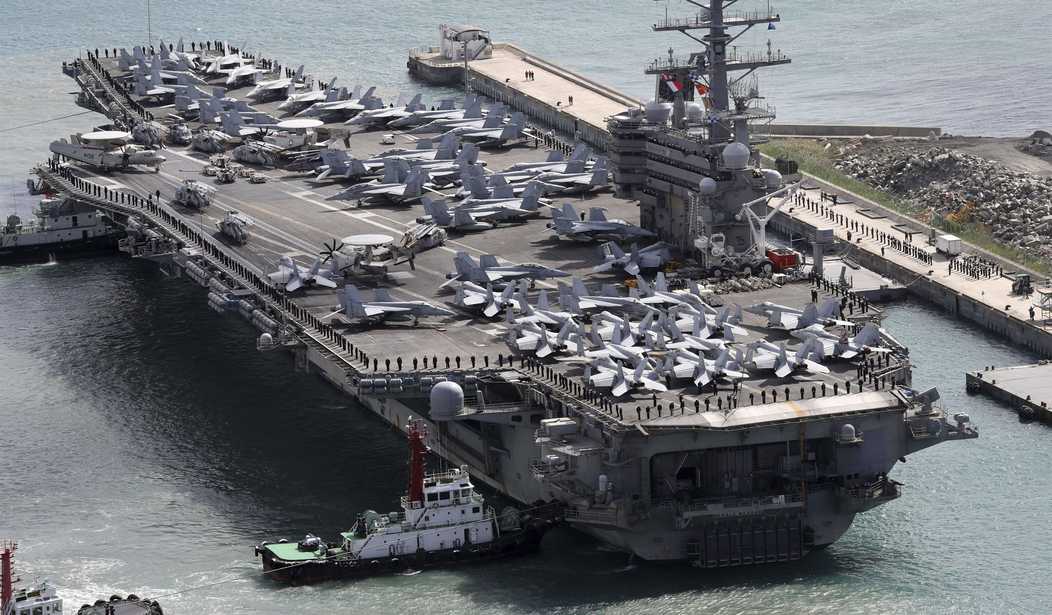 |
In today's national defense news, China is building a fourth aircraft carrier while the U.S. Navy's procurement remains stalled and the U.S. Air Force will shrink this year to its smallest size ever.
Let's take these items one at a time.
The South China Morning Post reported last week that PLA Navy political commissar Yuan Huazhi said that China's fourth carrier “will soon be announced" and that he added that "he had not heard of any 'technical bottleneck' regarding the aircraft carrier, suggesting its progress was on track."
Some believe that the as-yet-unnamed carrier will be China's first to use nuclear propulsion, according to a report today in Popular Mechanics. That would grant Communist China Navy entry into an exclusive club consisting today of just the U.S. Navy, "a major milestone in ship development and the key toward projecting Chinese military power abroad."
On our side of the Pacific, carrier production is behind schedule, over budget, and has less than zero room for error. Bryan McGrath warned in a new Defense One report that the Navy's plan to delay production of our next Ford-class carrier by two years would result in layoffs and further erode our shipbuilding base.
"These developments would represent steep challenges to the continued production of aircraft carriers. And because many suppliers of aircraft carrier parts also furnish components for submarines (both are nuclear-powered), the delay would also undermine the already insufficient submarine industrial base," he wrote.
Also, the Navy will sacrifice production of a vital Virginia-class nuclear-powered attack submarine in this year's budget to free up funds to keep suppliers in business. “We did reduce the funding to one Virginia-class submarine in FY25. But we maintain the funding for nine out of the planned 10 Virginia class” during the five-year procurement plan, Under Secretary Erik Raven was quoted in a Defense News report this week. We're also supposed to be producing Virginia subs for Australia but, at this point, we can't even meet our own needs. --->READ MORE HERE
 |
The President’s Pentagon budget reveals the armed forces in a state of managed decline.
President Biden opened his State of the Union address last week invoking Franklin D. Roosevelt in 1941. This week he rolled out a military budget fit for 1991, the twilight of the Cold War. Will Congress step up to defend the country amid compounding threats?
The President’s $850 billion request for the Pentagon in 2025 is a mere 1% increase over 2024. That’s a cut after inflation, the fourth in a row Mr. Biden has proposed. What’s happened in the past year? Israel was brutally attacked and is now fighting a war for survival. Iranian proxies have fired drones and rockets at U.S. troops in the region more than 100 times, and its terrorists in Yemen have taken a global shipping lane hostage.
Vladimir Putin’s war in Ukraine is a bloody slog that he could still win. North Korea is ratcheting up its belligerence toward South Korea, which the U.S. is bound to defend. China announced recently a 7.2% increase in defense spending. One recent think-tank report estimates Beijing is fielding high-end equipment five to six times faster than the U.S.
Mr. Biden thinks this is an acceptable moment to put American defenses on a diet, and the Administration says it’s merely complying with budget caps negotiated last year with Congress. Yet few priorities escaped the axe.
The U.S. Army will contract, and not because America is relying less on land forces, which are in high demand in Europe and the Middle East. The Army is asking for 442,300 troops, though the Biden Administration requested 485,000 as recently as 2022. The healthier number for the missions required is 500,000. Shrinking the force is no substitute for fixing the underlying problem, which is a struggle to find recruits.
The U.S. Navy will purchase only six ships and retire 10 early, which would shrink the fleet to 287 ships in 2025 from 296 today. Perhaps the most egregious choice is the Administration’s decision to purchase only one Virginia-class attack submarine, instead of a planned two.
U.S. submarine technology is a crown jewel of American military power and a true advantage over a rapidly expanding Chinese naval fleet. The industrial base is struggling to produce two boats a year, and the Administration presents its decision as a concession to this incapacity. --->READ MORE HERE (or HERE)Follow link below to a relevant story:
In 2024, the U.S. Military Is Weak…and That Should Scare You
If you like what you see, please "Like" and/or Follow us on FACEBOOK here, GETTR here, and TWITTER here.

No comments:
Post a Comment